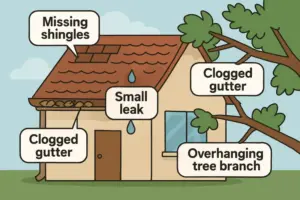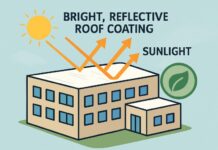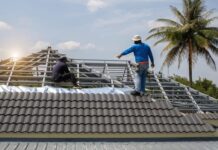Key Takeaways
- Regular inspections can identify potential roofing issues before they escalate.
- Addressing minor problems promptly can prevent extensive damage and costly repairs.
- Proper maintenance extends the lifespan of your roof and enhances home safety.
Table of Contents
- Introduction
- Leaks and Water Damage
- Damaged or Missing Shingles
- Poor Ventilation
- Clogged Gutters
- Flashing Failures
- Tree Damage
Introduction
A strong, healthy roof is one of your home’s most important defenses against the unpredictable forces of weather, invasive pests, and the threat of serious structural damage. Despite their robust construction, all roofs are susceptible to hidden vulnerabilities as they age or face extreme weather events. Whether your home is newly built or decades old, being proactive about roof care is crucial for maintaining your property’s safety and value. Proactively identifying common roofing issues goes a long way in avoiding unexpected emergencies, intrusive leaks, and expensive repair bills. Should you notice any warning signs—such as damp spots, missing shingles, or other visible damage—don’t wait for the problem to worsen. Quick action is key, and often calling a roof repair specialist ensures both a swift, thorough solution and continued peace of mind. By staying ahead of roof issues, you safeguard not just your home but your family as well.
Roof damage is rarely caused by just one factor; instead, it’s often the result of a combination of seasonal weather shifts, falling debris, nearby vegetation, and natural wear and tear. This is why informed homeowners take a proactive stance—keeping their eyes out for common risks and understanding when to tackle repairs alone versus when to call an expert. By being attentive to the common pitfalls presented below, you equip yourself with the knowledge to protect your home’s most critical barrier from preventable deterioration. Ultimately, investing effort now in regular roof maintenance will save you substantial money, extend the life of your roof, and let you enjoy each season with confidence.
Leaks and Water Damage
Water leaks are among the most persistent and destructive problems any roof can face, silently eroding the safety and comfort of your home. These leaks often originate from tiny shingle cracks, damaged flashing, aging sealants, or even more subtle issues such as structural shifting over time. Early warning signs are easy to miss but often include discolored ceiling patches, peeling or bubbling wall paint, visible dampness, or even an unexpected musty odor in attic spaces. It is important to recognize that even a minor drip can escalate rapidly, working its way into insulation, encouraging mold growth, and causing wood to rot. The consequences of unchecked leaks extend well beyond surface damage and can compromise the integrity of your home’s entire structure. To minimize the risk, inspect your roof regularly—ideally after each major storm or heavy rain—and look for early signs of leaks. Immediate, professional repairs help ensure small problems don’t evolve into major headaches, saving you from expensive restoration and health hazards caused by mildew and mold.
Damaged or Missing Shingles
Shingle problems are one of the most recognizable roof issues, especially after turbulent weather conditions like high winds, hail, or prolonged exposure to intense sunlight. Over time, shingles can loosen, crack, curl, or even be torn off completely. Each condition leaves the vulnerable underlayment and roof decking exposed to the elements. Once compromised, moisture can infiltrate, resulting in deeper leaks, deck rotting, and eventual structural sagging. You might also notice granule loss—the small particles that coat asphalt shingles—which appears as bare patches or granules collecting in gutters. To prevent further deterioration, homeowners should visually scout their roofs at least twice a year and follow major storms for missing or damaged shingles. Prompt attention to even minor shingle problems, including timely replacement or repairs, will greatly extend your roof’s life and stave off much more extensive fixes down the line. If there’s any uncertainty or you spot widespread damage, consider a professional inspection for an expert evaluationand resolution.

Poor Ventilation
Efficient ventilation is essential for maintaining a balanced environment in your attic and throughout your roofing system. Without proper airflow, heat and moisture can quickly accumulate under the roof, particularly during the hottest days of summer or bitterly cold spells in winter. Signs of inadequate ventilation can include an overly warm attic, visible mold growth, corrosion on metal fixtures or nails, and a persistent musty smell. In hot weather, heat buildup can curl or warp shingles, reduce your home’s overall energy efficiency, and increase cooling costs. During winter, trapped moisture condenses, leading to wood rot in rafters and supports, or contributing to damaging ice dams along the roof edges. Remedying poor ventilation often requires a careful balance of intake and exhaust vents to promote continuous fresh airflow. Regularly checking for blocked vents or insulation mishaps is invaluable in maintaining roof health. Homeowners should not overlook subtle hints of poor airflow, as swift correction will prevent both material damage and rising utility expenses.
Clogged Gutters
Gutters are a fundamental part of your roof’s drainage system, safely channeling rainwater away from your home’s foundation. When gutters are obstructed with leaves, twigs, or other debris, water can back up and pool along the roof’s edge. This stagnant moisture is capable of causing a range of problems, from encouraging shingle rot to undermining the very foundation of your home. Additionally, overflowing gutters become especially hazardous in colder months, as they’re prone to forming ice dams that can drive water up under shingles and into attic spaces. The result can be pervasive leaks, mold, and damage not just to the roof, but to walls and even basements. To prevent these issues, homeowners should prioritize gutter cleaning at least twice yearly, particularly during autumn and spring, when debris is most abundant. Installing gutter guards is an effective way to reduce future buildup and maintenance. If you’re unsure about the current state or function of your gutter system, it’s wise to request the expertise of a reputable roofing service for inspection and advice. For practical, step-by-step maintenance tips, consider referencing this helpful gutter maintenance guide.
Flashing Failures
Roof flashing—typically thin strips of metal installed at joints, valleys, and around roof penetrations such as chimneys, skylights, and vents—serves a vital waterproofing role. Over the years, repeated exposure to moisture, high winds, and thermal expansion can cause flashing to rust, lose its seal, or even warp and crack. Once flashing fails, it directly exposes vulnerable parts of your roof’s framework to water intrusion, often resulting in leaks that are hard to detect until they’ve already caused considerable damage. Water from failed flashing can easily enter spaces behind walls and under floors, leading to expensive repairs and even threatening the structural soundness of your home. Inspections of flashing should be part of your routine roofing checks, especially after severe weather. Look for signs of corrosion, gaps, or areas where the metal has lifted. Given the technical skill involved in repairing or replacing flashing, it’s generally recommended that such work be performed by roofing professionals who are familiar with industry-standard waterproofing techniques and materials.
Tree Damage
While mature trees can enhance curb appeal and provide shade, they pose unique risks to your roof, especially when branches overhang or directly interact with roofing materials. Even gentle brushing can erode shingle granules, lift shingles, or crack roof tiles. Severe storms increase the risk, where falling limbs can puncture roofing layers or cause significant structural harm. At the same time, accumulated leaf litter in valleys or gutters can promote rot and moisture buildup. The best way to safeguard your roof is to routinely trim back branches to keep them at least six feet away, and promptly remove any dying or hazard-prone trees from around your property. Regular, proactive landscaping preserves your roof’s longevity and maintains your home’s aesthetics and safety. If you’re unsure which trees are most likely to cause problems, contact a local arborist or roofing expert for guidance and preventative measures. Check out this excellent tree damage prevention resource for additional strategies to protect your roof from environmental hazards.
Caring for your roof entails a proactive approach to common problems that could otherwise lead to significant distress or financial loss. By understanding and addressing these widespread roofing issues the moment they arise, homeowners can dramatically increase the functional lifespan of their roof. Staying ahead of trouble curbs unnecessary expenses and ensures that your living environment remains safe, dry, and worry-free for everyone under your roof. Whenever in doubt, remember that experienced professionals are just a call away via K Single Corp’s roof repair services, ensuring your home receives the protection and care it deserves.






